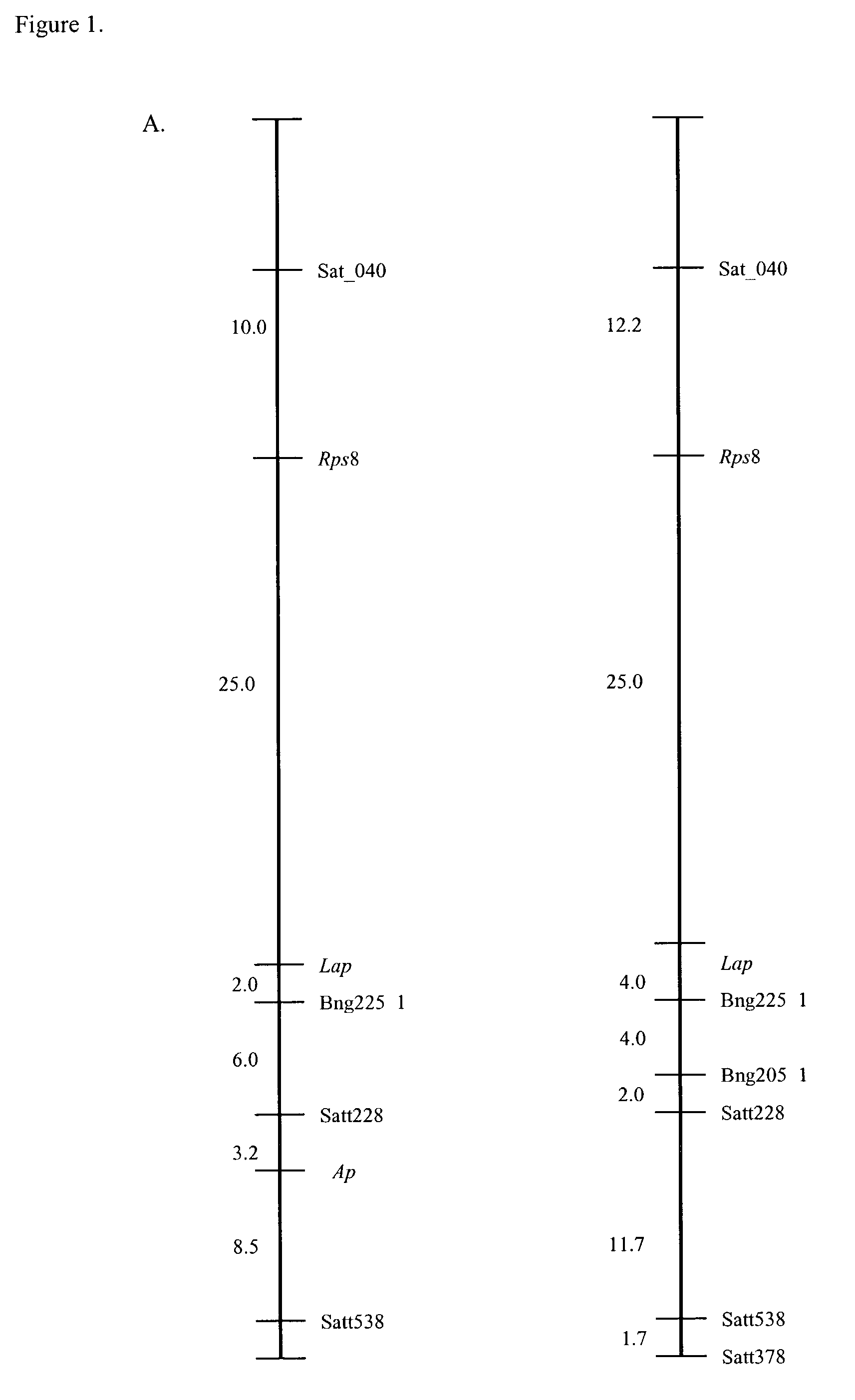Identification of soybeans having resistance to Phytophthora sojae
a technology of phytophthora and soybeans, applied in the field of soybean plants, can solve problems such as loss of yield, and achieve the effect of confirmating the selection of phytophthora resistan
- Summary
- Abstract
- Description
- Claims
- Application Information
AI Technical Summary
Benefits of technology
Problems solved by technology
Method used
Image
Examples
example 1
Phenotypic Evaluation of Rps8-Derived Phytophthora sojae Resistance
[0068]Korean plant introductions (PI399073) were obtained from the USDA Soybean Germplasm Collection in Urbana, Ill. All other plant material was obtained from the Ohio Agricultural Research Development Center (OARDC) soybean breeding program. The crosses used for mapping the new Rps8 allele were Williams (Rps) X PI399073 and S 19-90 (Rps1c) X PI399073. The F1 plants from these crosses were selfed to produce populations of approximately 40 to 60 F2 plants for each cross. The F2 plants were then selfed and each plant was thrashed individually to yield seed for F2:3 families.
[0069]Isolates of P. sojae pathotypes were maintained at the Department of Plant Pathology, OARDC. All pathotypes used in this study were collected in Ohio. Three isolates of P. sojae were used in this study with the following pathotypes OH1 (vir 7), OH17 (vir 1b, 1d, 3a, 3b, 3c, 4, 5, 6, 7), and OH25 (vir 1a, 1b, 1c, 1k, 7). Differential checks, W...
example 2
Simple Sequence Repeat (SSR) DNA Length Polymorphism Markers Indicating Association of SSR Marker Satt228 with Phytophthora sojae Resistance in PI399073, thus Placing the Novel Trait Locus for Rps8 on Major Linkage Group (MLG) A2
[0075]The cross used for analyzing SSR marker association was Williams (Rps) X PI 399073. The F1 plants from this cross were selfed to produce a population of approximately 40 to 60 F2 plants. The F2 plants were then selfed and each plant was thrashed individually to yield seed for F2:3 families.
[0076]Leaves from individual F3 seedlings were bulked from each F2:3 family, and DNA was extracted according to the protocol previously described (Burnham et al., 2002). SSR primer pairs (Research Genetics Inc., Huntsville, Ala.), polymorphic for the parents in each cross, were used to test the F2:3 progeny. PCR reactions were performed as recommended by the manufacturers in a total of 25 μl containing 30 ng of genomic DNA. Amplified PCR products were resolved on 5% ...
example 3
Demonstration of Linkage of Acid Phosphatase Isozyme Locus to the Resistance Locus for Rps8
[0082]Fresh leaf tissue was used to detect the presence of the isozymes acid phosphatase (Ap) (E.C. 3.1.3.2) and leucine aminopeptidase (Lap) (E.C. 3.4.11.1). Leaves from each F2:3 family were collected, placed on ice, and then placed in grinding buffer (10 ml 0.1M Tris-HCL pH 8.0, 0.5 ml β-mercaptoethanol, 50 mg PVP (polyvinylpolypyrrolidone)). Samples were ground immediately prior to loading on cellulose acetate membrane. Electrophoresis was carried out at 200 V for 20 minutes in CAAPM running buffer (8.4 g citric acid, 10 ml 4-(3-aminopropyl) morpholine per liter).
[0083]The stain for Ap contained 3 ml of acetate ACP acetate buffer (2.43 g sodium acetate trihydrate, 4.7 ml glacial acetic acid, 5.0 ml 1.0M MgCl2 per liter), 4 mg α napthyl acid phosphate, 3.2 mg of fast garnet GBC salt, and 2 ml of 2% agarose. The stain for Lap contained 2 ml 0.1M Tris maleate, 1 mg L-leucine β naphthylamide H...
PUM
| Property | Measurement | Unit |
|---|---|---|
| Tm | aaaaa | aaaaa |
| Tm | aaaaa | aaaaa |
| Tm | aaaaa | aaaaa |
Abstract
Description
Claims
Application Information
 Login to View More
Login to View More - R&D
- Intellectual Property
- Life Sciences
- Materials
- Tech Scout
- Unparalleled Data Quality
- Higher Quality Content
- 60% Fewer Hallucinations
Browse by: Latest US Patents, China's latest patents, Technical Efficacy Thesaurus, Application Domain, Technology Topic, Popular Technical Reports.
© 2025 PatSnap. All rights reserved.Legal|Privacy policy|Modern Slavery Act Transparency Statement|Sitemap|About US| Contact US: help@patsnap.com

